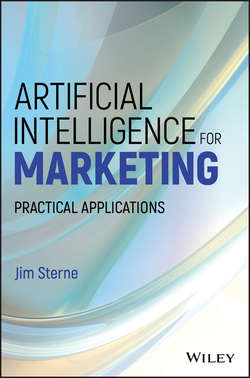Читать книгу Artificial Intelligence for Marketing - Sterne Jim - Страница 10
На сайте Литреса книга снята с продажи.
CHAPTER 1
Welcome to the Future
WELCOME TO ARTIFICIAL INTELLIGENCE FOR MARKETERS
ОглавлениеIt is of the highest importance in the art of detection to be able to recognize, out of a number of facts, which are incidental and which vital.
Sherlock Holmes, The Reigate Squires
This book looks at some current buzzwords to make just enough sense for regular marketing folk to understand what's going on.
■ This is no deep exposé on the dark arts of artificial intelligence.
■ This is no textbook for learning a new type of programming.
■ This is no exhaustive catalog of cutting‐edge technologies.
This book is not for those with advanced math degrees or those who wish to become data scientists. If, however, you are inspired to delve into the bottomless realm of modern systems building, I'll point you to “How to Get the Best Deep Learning Education for Free”2 and be happy to take the credit for inspiring you. But that is not my intent.
You will not find passages like the following in this book:
Monte‐Carlo simulations are used in many contexts: to produce high quality pseudo‐random numbers, in complex settings such as multi‐layer spatio‐temporal hierarchical Bayesian models, to estimate parameters, to compute statistics associated with very rare events, or even to generate large amount of data (for instance cross and auto‐correlated time series) to test and compare various algorithms, especially for stock trading or in engineering.
“24 Uses of Statistical Modeling” (Part II)3
You will find explanations such as: Artificial intelligence is valuable because it was designed to deal in gray areas rather than crank out statistical charts and graphs. It is capable, over time, of understanding context.
The purpose of this tome is to be a primer, an introduction, a statement of understanding for those who have regular jobs in marketing – and would like to keep them in the foreseeable future.
Let's start with a super‐simple comparison between artificial intelligence and machine learning from Avinash Kaushik, digital marketing evangelist at Google: “AI is an intelligent machine and ML is the ability to learn without being explicitly programmed.”
Artificial intelligence is a machine pretending to be a human. Machine learning is a machine pretending to be a statistical programmer. Managing either one requires a data scientist.
An ever‐so‐slightly deeper definition comes from E. Fredkin University professor at the Carnegie Mellon University Tom Mitchell:4
The field of Machine Learning seeks to answer the question, “How can we build computer systems that automatically improve with experience, and what are the fundamental laws that govern all learning processes?”
A machine learns with respect to a particular task T, performance metric P, and type of experience E, if the system reliably improves its performance P at task T, following experience E. Depending on how we specify T, P, and E, the learning task might also be called by names such as data mining, autonomous discovery, database updating, programming by example, etc.
Machine learning is a computer's way of using a given data set to figure out how to perform a specific function through trial and error. What is a specific function? A simple example is deciding the best e‐mail subject line for people who used certain search terms to find your website, their behavior on your website, and their subsequent responses (or lack thereof) to your e‐mails.
The machine looks at previous results, formulates a conclusion, and then waits for the results of a test of its hypothesis. The machine next consumes those test results and updates its weighting factors from which it suggests alternative subject lines – over and over.
There is no final answer because reality is messy and ever changing. So, just like humans, the machine is always accepting new input to formulate its judgments. It's learning.
The “three Ds” of artificial intelligence are that it can detect, decide, and develop.
Detect
AI can discover which elements or attributes in a subject matter domain are the most predictive. Even with a great deal of noisy data and a large variety of data types, it can identify the most revealing characteristics, figuring out which to heed to and which to ignore.
Decide
AI can infer rules about data, from the data, and weigh the most predictive attributes against each other to make a decision. It can take an enormous number of characteristics into consideration, ponder the relevance of each, and reach a conclusion.
Develop
AI can grow and mature with each iteration. Whether it is considering new information or the results of experimentation, it can alter its opinion about the environment as well as how it evaluates that environment. It can program itself.
2
“How to Get the Best Deep Learning Education for Free,” http://www.topbots.com/artificial‐intelligence‐deep‐learning‐education‐free.
3
“24 Uses of Statistical Modeling (Part II),” http://www.datasciencecentral.com/profiles/blogs/24‐uses‐of‐statistical‐modeling‐part‐ii.
4
“The Discipline of Machine Learning,” http://www.cs.cmu.edu/∼tom/pubs/MachineLearning.pdf.
